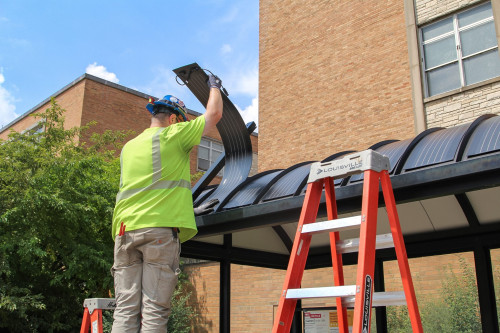08 Feb UW–Madison launches ambitious environmental sustainability initiative

A contractor places flexible solar panels atop a bus shelter on Engineering Drive. The unique, flexible design of the panels was a student-driven solution. The panels power the shelter’s lights and screens displaying updates on routes. UW Office of Sustainability.
The University of Wisconsin–Madison has a rich history of advancing environmental sustainability through its excellence in fields ranging from ecology to wildlife biology to satellite technology. Building on this tradition, the university is launching a new cross-campus initiative focused on environmental sustainability, centered around five goals that include the launch of an interdisciplinary research hub.
Chancellor Jennifer L. Mnookin formally announced the initiative at the meeting of the University of Wisconsin Board of Regents on Thursday, Feb. 8.
The plan represents the most comprehensive environmental sustainability initiative in UW–Madison’s history and will advance the university’s research and education missions while also making campus a living laboratory for sustainable practices.
With the goals as a guide, UW–Madison will be on a course to drastically reduce our campus’s and physical plant’s impact on the environment, cultivate a culture of sustainability, build climate resilience, and inspire innovations that will benefit campus, the people of Wisconsin and the planet.
“This initiative builds on UW–Madison’s great Wisconsin Idea, our tradition of innovation for the public good,” says Mnookin. “It prioritizes issues that affect the people and communities of our state. We owe it to Wisconsin to further demonstrate leadership in sustainability and stewardship of our planet. These goals set us on our way while building on the great strides we’ve taken in recent years.”
The new initiative is structured around the following five goals:



